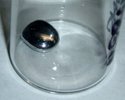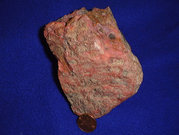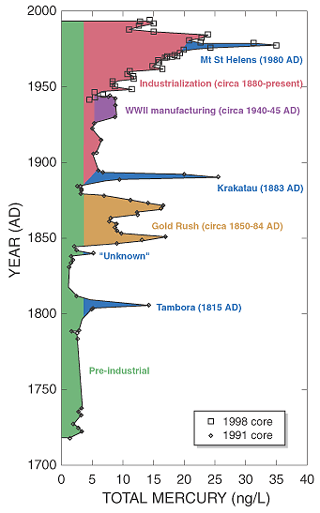HEAVY-METAL MERCURY (Hg) is a toxic element. It is also a bactericidal agent among other antimicrobial agents, such as penicillin, sulfa, and tetracycline. Dental amalgam fillings contain approximately 50% mercury, (1) and it is widely accepted that such fillings can release mercury into the environment. (2-14) In bacteria, the genes for mercury resistance and antimicrobial resistance are found together. (13,15,16) Resistant bacteria are widespread in the environment (17,18) and can cause severe difficulties when infections are treated with antimicrobial agents. Furthermore, the environmental load of mercury, including that released from amalgam fillings, may promote and maintain both antimicrobial resistance and mercury resistance. (11) All factors and possible routes that facilitate the development of antimicrobial-resistant organisms need to be considered. Therefore, a more profound understanding is needed of factors affecting the discharge of mercury into the environment.
In the present article, the authors examined mercury in human saliva as a pollutant. The authors used odds ratios (ORs) to calculate the risk of exceeding the mercury limits for sewage in relation to exposure to dental amalgam "silver" fillings.
Materials and Method
Subjects. All study subjects (N = 187) were adult Finnish outpatients from the Students' Health Care Center at the University of Turku and from 3 private dental surgical practices (mean age = 43 yr, range = 19-83 yr; women = 62%, men = 38%). Patients with no exposure to dental amalgam fillings who visited the Students' Health Care Center on 2 predetermined days each week were also invited to participate in the study. We selected the names of the study subjects from the data banks of 3 private dental surgery practices by repeatedly drawing a random letter of the alphabet, and 10 consecutive subjects whose 1st letter of his or her last name matched the randomly selected letter were invited to participate. This procedure was repeated until a sufficient number of patients had been selected. We divided the subjects into 3 groups: the NAR group (n = 56), which contained individuals who had had their amalgam fillings removed (mean time since last removal = 390 days); the NA group (n = 43), which contained individuals who had never been exposed to dental amalgam fillings; and the A group (n = 88) comprising individuals who had various numbers of amalgam fillings. The characteristics of each group are given in Table 1.
Saliva samples and dental amalgam filling status. Special emphasis was placed on preventing mercury contamination during the study, and all study materials were tested for mercury traces prior to use. To standardize sampling, a paraffin-stimulated 5-mi whole-saliva sample was collected, and the dental amalgam filling status was recorded by the same experienced dentist (JL), who consistently used the same protocol. An amalgam-filled surface was defined as an amalgam filling that exceeded one-half of the area of the tooth surface.
Determination of total mercury content in saliva. The whole-saliva samples were frozen within 3 hr of collection and sent for analysis to the Oulu Regional Institute of Occupational Health, Oulu, Finland. Total mercury content (inorganic and organic) was determined by cold-vapor atomic absorption spectrometry (Varian Techtron, SpectrAA-400, Varian Associates [Sunnyvale, California]), in accordance with a modified version of the method described by Magos and Cernik. (19,20) This method can identify mercury concentrations as low as 1 nmol/l.
Statistical methods. We used logarithmic transformation to correct the skewed distribution of total mercury concentrations. The Hosmer and Lemeshow goodness-of-fit test approximated the fitness of the model. Fisher's exact test (2-tailed) examined the significance of the differences among the study groups. The groups were compared with the assistance of logistic models (21) in terms of the proportions of study subjects' saliva that exceeded the upper limit for mercury in sewage. We calculated ORs and 95% confidence intervals (CIs) to quantify the differences. Values of p less than .05 were interpreted as being statistically significant. Statistical calculations were performed with the SAS statistical program package (SAS System for Windows, release 6.12/1996).
Ethical approval. This study was approved by the Ethical Committee of Turku University.
Results
Concentration of total mercury in saliva. We found statistically significant (p = .001) higher total mercury concentrations in paraffin-stimulated saliva from the amalgam (A) group than from the nonamalgam groups (NA and NAR). The average level of mercury in the A group (i.e., 174 nmol/I) was 23 times higher than in the combined nonamalgam groups (i.e., 7.5 nmol/I). The NA and NAR groups had almost equal mercury levels in paraffin-stimulated saliva (Table 2).
Relation of total mercury in saliva to number of amalgam-filled surfaces. The association between mercury in saliva and the number of amalgam-filled surfaces was studied in subjects with 1 or more amalgam-filled surfaces. Given the skewed distribution, the data were logarithmically transformed. Following transformation, the shape of distribution closely approximated a normal distribution (p = .942). A clear and statistically significant ascending linear trend was observed for the association between the number of amalgam-filled surfaces and the logarithm of total mercury in saliva (p = .011) (Fig. 1). The estimated regression equation was as follows: logarithmic value of total mercury in saliva = 3.27 + 0.05 x no. amalgam-filled surfaces (95% CI [slope of the trend] = 0.026, 0.066).
[FIGURE 1 OMITTED]
Probability of exceeding the upper limit for mercury in sewage. In the A group, the limits for mercury in sewage were exceeded quite frequently. The council directive of the European Economic Community (84/156/EEC) specifies a limit of 0.05 mg/l (i.e., 250 nmol/l) effluent "on values and quality objectives for mercury discharges by sectors other than the chlor-alkali electrolysis industry." (22) This limit is used in the Finnish town of Turku, whereas in the capital--Helsinki--a limit of 50 nmol/l is used. (23) None of the nonamalgam groups exceeded thN PROCESS IN EASTERN AND CENTRAL EUROPE. Edited by Jurgen Rose & Johannes Ch. Traut. Hamburg, Germany: LIT Verlag. 2001. Pp. vii, 372. Cloth, $65.
GAIN-BASED DAMAGES: CONTRACT, TORT, EQUITY AND INTELLECTUAL PROPERTY. By James Edelman. Portland: Hart Publishing. 2002. Pp. xxxiii, 279. Cloth, $54.
GLOBAL PRESCRIPTIONS: THE PRODUCTION, EXPORTATION, AND IMPORTATION OF A NEW LEGAL ORTHODOXY. Edited by Yves Dezalay & Bryant G. Garth. Ann Arbor: The University of Michigan Press. 2002. Pp. 357. Cloth, $55.
PATHS TO JUSTICE SCOTLAND: WHAT PEOPLE IN SCOTLAND Do AND THINK ABOUT GOING TO LAW. By Hazel Genn & Alan Paterson. Portland: Hart Publishing. 2001. Pp. xv, 391. Paper, $35.
POLICING FOR LONDON: REPORT OF AN INDEPENDENT STUDY FUNDED BY THE NUFFIELD FOUNDATION, THE ESMEE FAIRBAIRN FOUNDATION AND THE PAUL HAMLYN FOUNDATION. By Marian FitzGerald, Mike Hough, Ian Joseph & Tarek Qureshi. Portland: Willan Publishing. 2002. Pp. xxiii, 166. Paper, $35.
PROPRIETARY REMEDIES IN CONTEXT: A STUDY IN THE JUDICIAL REDISTRIBUTION OF PROPERTY RIGHTS. By Craig Rotherham. Portland: Hart Publishing. 2002. Pp. xxix, 354. Cloth, $65.
THE CAMBRIDGE YEARBOOK OF EUROPEAN LEGAL STUDIES: VOLUME 3, 2000. Edited by Alan Dashwood, John Spencer, Angela Ward & Christophe Hillion. Portland: Hart Publishing. 2001. Pp. xlv, 558. Cloth, $110.
THE HAGUE TRUSTS CONVENTION: SCOPE, APPLICATION AND PRELIMINARY ISSUES. By Jonathan Harris. Portland: Hart Publishing. 2002. Pp. xlvii, 529. Cloth, $117.00.
THE SURVEILLANCE WEB: THE RISE OF VISUAL SURVEILLANCE IN AN ENGLISH CITY. By Michael McCahill. Portland: Willan Publishing. 2002. Pp. xvii, 219. Cloth, $55.
UK PUBLIC LAW AND EUROPEAN LAW. By Gordon Anthony. Portland: Hart Publishing. 2002. Pp. xxvii, 198. Cloth, $60.
LAW AND PHILOSOPHY
RESPONSIBILITY IN LAW AND MORALITY. By Peter Cane. Portland: Hart Publishing. 2002. Pp. xii, 303. Cloth, $45.
LAW AND RELIGION
SEPARATION OF CHURCH AND STATE. By Philip Hamburger. Cambridge: Harvard University Press. 2002. Pp. xiii, 514. Cloth, $49.95.
LEGAL HISTORY
LIVES IN THE LAW. Edited by Austin Sarat, Lawrence Douglas & Martha Merrill Umphrey. Ann Arbor: The University of Michigan Press. 2002. Pp. 243. Cloth, $55.
POLICING AND PUNISHMENT IN LONDON, 1660-1750: URBAN CRIME AND THE LIMITS OF TERROR. By J. M. Beattie. New York: Oxford University Press. 2001. Pp. xix, 491. Cloth, $74.
THE LOCHNER COURT, MYTH AND REALITY: SUBSTANTIVE DUE PROCESS FROM THE 1890S TO THE 1930S. By Michael J. Phillips. Westport: Praeger Publishers. 2001. Pp. x, 210. Cloth, $72.95.
LEGAL PRACTICE
MODERN LEGAL DRAFTING: A GUIDE TO USING CLEARER LANGUAGE. By Peter Butt & Richard Castle. New York: Cambridge University Press. 2001. Pp. xxvi, 181. Cloth, $60; paper, $23.
PUBLIC POLICY
SMOKE-FILLED ROOMS: A POSTMORTEM ON THE TOBACCO DEAL. By W. Kip Viscusi. Chicago: The University of Chicago Press. 2002. Pp. viii, 263. Cloth, $27.50.
COPYRIGHT 2002 Heldref Publications
COPYRIGHT 2003 Gale Group




